Imagicnation #04 | How Do Bees Manufacture Honey??
Hello everyone ! Welcome to the brand new episode of Imagicnation ! A place where we will find out the answers to some of the most interesting & curious questions related to science...
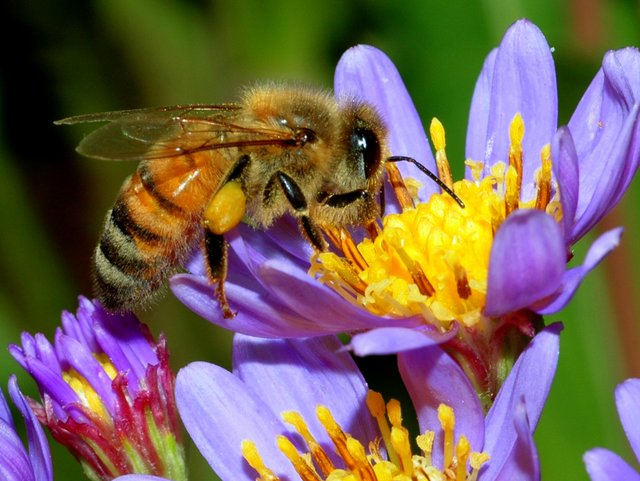
Hey guys…what’s up??? Did the topic above remind you of your lovely breakfast?? Well, the breakfast last morning reminded me of the topic above !! Haha…jokes apart…have you ever wondered how the bees really manufacture the honey?? Or are you still living with the little knowledge from your high schools that it happens just as a result of pollination ??!! Well, then I must say that you are wrong…I mean relatively wrong ! Actually, honey making is an extremely complex process which requires several processes, including pollination. So, here it starts:
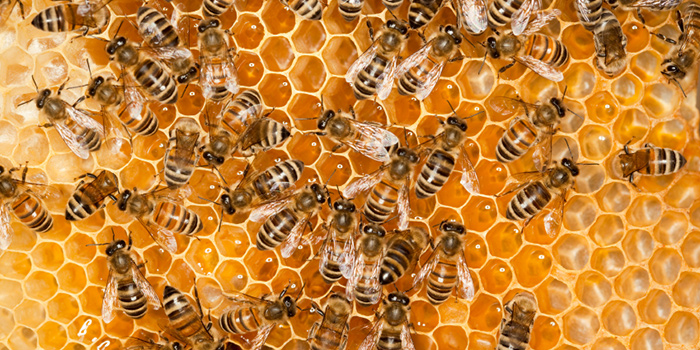
Did you know that one healthy hive will manufacture and consume more than 50 kg of honey in a year, and that takes a tremendous hard-work??!!! Honey is made from nectar, but it doesn’t come out of flowers as that golden, thick, sticky thing. After discovering a suitable food source, bees dive in headfirst using their long specially adapted tongues to slurp minute sips of nectar into one of their two stomachs !! One single bee might have to drink about more than a thousand flowers to fill its honey storing stomach which can weigh as much as the bee itself when full of nectar. On the way back to the hive, digestive enzymes are released to convert that nectar into sweet gold. When she returns to the hive, the carrier bee will vomit the nectar into the mouth of another worker. Then that bee will vomit it into another bee’s mouth and so on. This game of vomit transfer is an important part of the honey making process since each bee adds more and more digestive enzymes to convert long chains of complex sugars in the raw nectar into simple monosaccharides like fructose and glucose. At this point, the nectar is still quite watery, so the bees beat their wings and generate an air current within the hive to evaporate and thicken the nectar, finally capping the cell with beeswax, so the enzyme rich bee-barfcan complete its transformation into HONEY. Because of its low water content and slightly acidic pH, honey isn’t a very pleasing place for bacteria or yeast spoilage, and it has an incredibly long shelf life in the hive or in your pantry. Honey has been found in Egyptian tombs dating thousands of years back quite much unspoiled… although I would not eat it for myself, just in case!
For one pound of honey, tens of thousands of forager bees will together fly over three times around the world and visit up to 8 million flowers. That takes extreme teamwork and organization, and although they can’t chat, they do communicate….with their body language. Foragers dance to express other bees where to find food. A circle dance tells flowers are quite near to the hive, but for food that’s farther away they get their waggle on. The waggle dance of the honey bee was first cracked by Karl von Frisch, and it’s definitely one of the most beautiful examples of animal communication in nature.
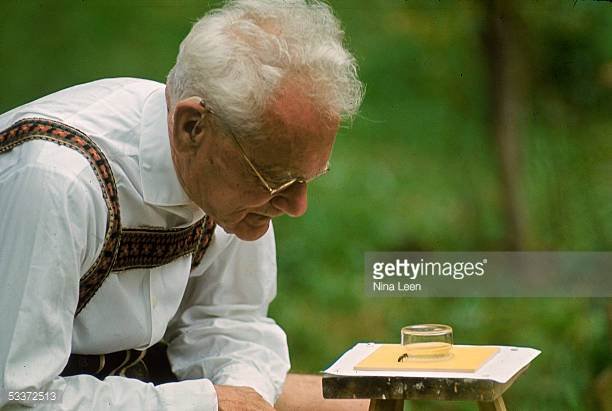
Karl von Frisch(Credits)
First the bee walks in a straight line, waggling its body back and forth and beating its wings, before repeating in a number ‘8’ pattern. Whatever angle the bee moves while waggling, expresses the other bees which direction to go. Straight up the line of honeycombs, then the diet lies in the direction of the sun. If the dance is headed to the left or right, the other bees recognize to fly in that angle relative to the sun.
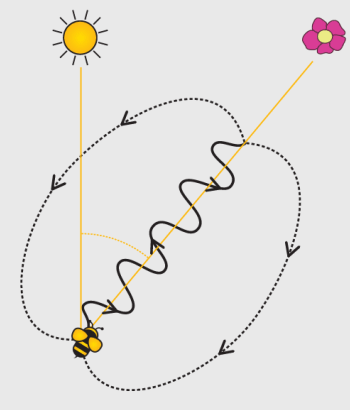
Fig. Waggle Dance(Credits)
The lengthier the waggle the farther away the food is, and the better the food, the more excited the bee shakes its body. If that’s not astonishing enough even if they can’t see the sun itself they can deduce where it is and the time of day by reading the polarization of light in the blue sky. A single bee is a little simple creature, but united they create highly complex and social societies. There’s three main classes in a beehive: Drones, workers, and queens.
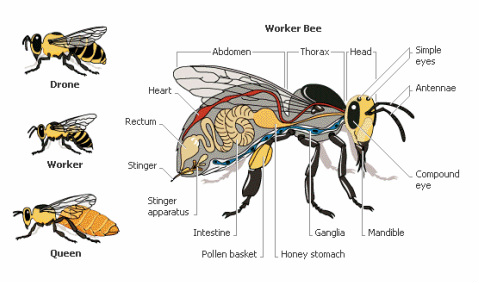
Fig. Types of honey bees (Credits)
When a new queen is born, she immediately runs around and murders her sisters, because there can be only one queen. During mating season, she’ll fly to a distant hive to mate with several male bees and accumulate away the sperm which she’ll use back at her home hive to produce more than a thousand eggs per day throughout the rest of her life. Any unfertilized eggs those that don’t patch-up with sperm will mature into male drones which means they only have a single set of chromosomes. But fertilized eggs are entirely genetically female fated to develop either queens or workers. Queens do the egg laying of course, but worker bees are the vertebra of the beehive. So, what makes most female bees to develop into workers while just one wears the hive crown? A baby bee’s diet activates genetic programming that modifies its complete destiny. Every bee larva is firstly fed a nutrient rich food called royal jelly, but after a few days worker bee babies are substituted to a mixture of pollen and honey called “bee bread”. But queens consume royal jelly their entire life even as adults. Scientists used to ponder it was only royal jelly that put queens on the throne, but just last year they discovered a chemical in bee bread, the food that queens don't get, that keeps worker bees sterile. Being a queen appears to be as much about what bees don't eat as what they do.
So, all I want to say is…

Making honey is insect farming on its magnificent scale with complicated societies, co-operating to make a food fit for bear tummies big and small… with the lovely side effect of pollinating most of the world’s flowering plants…I would say, it’s a quiet "sweet deal " !!!!
That’s all for today guys…
Hope you will you appreciate the hard-work…I mean of the honey bees…
…& yess…please feel free to express your thoughts about the post in the comment section below…
References used:

1) https://en.wikipedia.org/wiki/Honey_bee
2) http://animals.howstuffworks.com/insects/bee6.htm
3) http://www.hiveandhoneyapiary.com/2015/06/09/how-bees-make-honey/
4) http://honeybee.org.au/education/wonderful-world-of-honey/how-bees-make-honey/
Last four science episodes:
1) Imagicnation #03 | Bioluminescence : Nature's living light-shows !!
2) Imagicnation #02 | What Would Happen if You Were Shrunk?
3) Imagicnation #01 | How much plastic is in the ocean ??
4) Life #01 | The Most Important Moment in the History of Life on Earth ! !

I would rate this post as the best ever by @imagicnation i feel very happy and it should be a benchmark for other minnows ..
My all the best wishes are always with you @imagicnation ....would like to see more out of your scientific brain .....
I wish this post earn over 100 SBD..... Thank you...
Thank you again @sthitaprajna...feels really great to get appreciated by people like you...it's inspiring !
...& I too wish that your wish to come true, but I guess this post wont cross even 10 SBD...perhaps they want me to write even more better ! :)
Wonderful post very informative it's truly amazing what we can learn from just observing and studying nature at work
yesss...all we need to do is invest some time for nature...(thanks)
Honey is the tastiest vomit I have ever tried!
yepp @trumpman...the only vomit which nobody wants to stop...rather they keep asking for more and more !
Join us on #steemSTEM / Follow our curation trail on Streemian
Thank you for this very interesting article. It has been advertised on our chat channel (and upvoted).
The steemSTEM project is a community-supported project aiming to increase the quality and the visibility of STEM (STEM is the acronym for Science, Technology, Engineering and Mathematics) articles on Steemit.
thank you again @steemstem...
I didn't know about this vomit thing.... I will never again look to honey in the same way as before ... ;)
haha... most have probably changed their breakfasts after reading this post :D